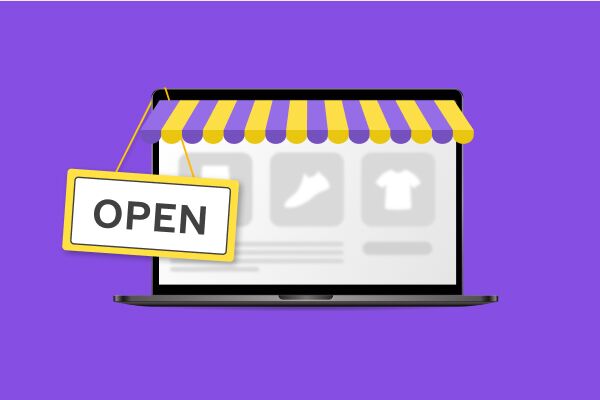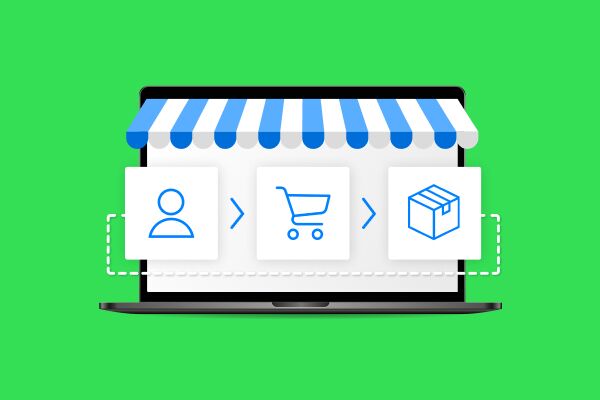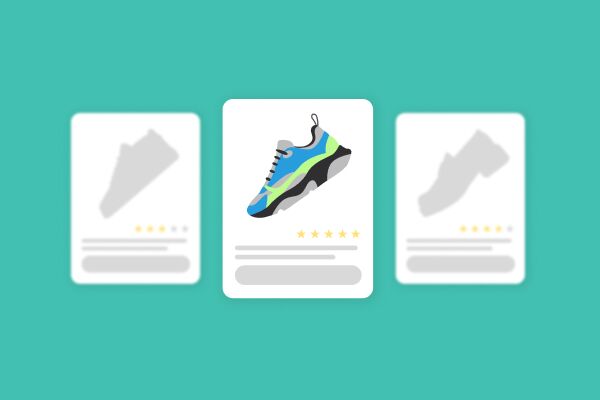- Step 1: Niche Selection
- Step 2: Defining the Target Audience
- Step 3. Search for Reliable Suppliers
- Step 4. Creating a Website
- Step 5. Setting up the website
- Step 6. Legal formalities
- Step 7. Brand creation
- Step 8. Promoting the Online Store
- Step 9. Traffic and Sales Analysis
- Step 10. Scaling the Business
- Conclusion
Online sales are one of the most popular and accessible ways to start your own business. To some, creating an online store may seem very difficult, but if you prepare for the process, everything will go smoothly. Cartum has been working in e-commerce since 2014, so we know the questions and difficulties faced when launching an online store. Based on our experience, we created an article that outlines the steps to creating an online store.
Online sales are one of the most popular and accessible ways to start your own business. To some, creating an online store may seem very difficult, but if you prepare for the process, everything will go smoothly. Cartum has been working in e-commerce since 2014, so we know the questions and difficulties faced when launching an online store. Based on our experience, we created an article that outlines the steps to creating an online store.
Step 1: Niche Selection
The niche in e-commerce is the sphere of activity that an online store deals with. The niche directly depends on the assortment of goods in the store. For example, the sale of sports clothing, bedding, furniture, etc. As we know, you can buy anything online, so there are hundreds of niches in e-commerce. The task of a future entrepreneur, who is planning to open an online store, is to decide in which niche he will work.
There are successful sellers in each niche, so it is not worth looking for one single golden vein. It is important to approach the choice of a niche for the online store correctly and, first of all, consider your interests. Working with an interesting topic for you that also brings a constant profit is very different from selling boring goods for you. You will receive an additional incentive to work and you will be an expert in the niche. For customers, it is very important that the seller knows their products well and is interested in them.
-
Your personal interest in the niche is equally as important as profit. This shows that you will be dedicated to your work and your enthusiasm will help you achieve success.
-
The niche has prospects for scaling the business in the future. For example, if you start with shoes for women, you can later add positions for men and children.
-
You have analyzed the main competitors and already know how you will differ from them. This can be high expertise in customer consultation, lower prices, exclusive products, etc.
Start your niche selection by analyzing your interests. Think about what you are passionate about and what products you frequently use. For example, you are well-versed in cosmetic brands and from your personal experience, you know what skin care products are the best. This information can easily become the basis for launching an online cosmetics store.
If you can't decide on a niche, study the market. Marketing platforms and various e-commerce platforms regularly publish reports on trending products. Look at which of these products you would be interested in selling. You can also check the trendiness of products yourself using analytical tools. For example, you can use Google Trends to find out how popular a certain search query is. Look at how actively users are searching for information related to the products and decide if this niche is promising.
Step 2: Defining the Target Audience
The target audience is the group of people who are interested in your product or information about it. They will be making purchases from you, using your products, and seeing the advertisement for your online store. Almost all of the activity of the online store depends on the target audience, as the actions of the seller must satisfy their customers. Every decision made by the entrepreneur must take the target audience into consideration. You must understand how your audience will react to what you do, and take that into account in your work.
The importance of understanding your target audience can be illustrated by the story of the well-known company, Burger King. In 2013, Burger King launched an advertisement for a diet French fry, but it failed because the target audience for fast food doesn't worry about healthy eating. As a result of not considering the target audience, the company canceled the release of the diet French fry. A lot of money was invested into the production and promotion of the new product, which ended up being lost.
Knowing the niche in which you will work, you will be able to compose a portrait of your target audience. A target audience portrait is a set of characteristics of your average buyer. For example, age, family status, place of residence, interests, etc. By gathering information about your target audience, you will be able to:
-
fine-tune your advertising;
-
formulate messages that will resonate with your audience;
-
understand triggers for influencing clients;
-
determine the main channels for promotion.
-
The audience of an online store is heterogeneous, so you will later segment it.
For example, let's say you sell wedding dresses. Your target audience can be divided into:
-
primary audience — people who make a decision to purchase, specifically brides;
-
indirect audience — people who are related to the purchase, such as mothers of brides who give advice or pay for the purchase;
-
broad audience — all single girls;
-
narrow audience — brides who are looking for an A-line white dress with lace on the hem.
For each of these groups, you will have to write separate messages so that customers respond.
Step 3. Search for Reliable Suppliers
The smooth operation of an online store depends not only on its owner but also on third parties, particularly the supplier. Without a good supplier, the online store simply cannot give customers what they want — a diverse assortment and quality goods. The correct choice of supplier directly affects:
-
quality of the products you plan to sell;
-
the breadth of the assortment;
-
pricing policy;
-
regularity of deliveries;
-
the ability to scale.
To search for a supplier, use a simple Google search. There you will find catalogs of suppliers — specialized sites where entrepreneurs post their offers for cooperation. Also, look for suppliers in theme groups in messengers and social networks. In them, you will not only find sources of supplies, but also learn about the reviews of those who already cooperate with suppliers. Do not forget to pay attention to ordinary online stores. Some of them trade wholesale and are willing to supply goods to others.
During negotiations with suppliers, clarify:
-
what documents they provide for the products — this will confirm the quality of the goods, as well as help with their import or export;
-
what is the minimum purchase batch — this depends on your online store budget and what warehouse you will need;
-
what delivery methods are possible — the speed and regularity of deliveries affect the availability of goods in the online store, and this affects your ability to retain customers;
-
who is responsible for repairs or warranty obligations in case of conflicts with customers;
-
will the supplier provide descriptions and photos of the product — this affects the creation of an attractive product catalog, which is important for customers.
All of these points depend on the success of your future cooperation. Having received positive answers to all of these questions, you can safely enter into a contract with the supplier and start purchasing goods. To start, you can buy a test batch of goods to finally ensure its quality and then make larger purchases.
If you don't want to rent a warehouse and make bulk purchases, then you can use the dropshipping scheme. In this case, the supplier will send the goods directly to your customers. All you will be required to do is search for buyers and process orders.
Step 4. Creating a Website
You can sell online in different ways, but to create a real online store and full-fledged sales, you need a website. With its help, you can engage the most diverse promotion channels, give customers the best user experience and develop your brand. Creating a website from scratch is a thing of the past, because it's too expensive and takes too long. The best solution for creating an online store website is a cloud platform.
For example, on Cartum, customers get access to their site immediately after submitting their request. They don't have to wait for development — all they need to do is choose a ready-made design and configure the site to meet their needs. Customers receive a multi-functional site with all the necessary integrations and capabilities for successful sales. At the same time, they don't have to spend money on expensive developer services or constant modifications. Technical issues are handled by specialists and are included in the subscription cost.
During the creation of a website, it is necessary to register a domain name — this is the address of the website that is displayed in the address bar of the browser. Without it, the online store will not be able to start its work. The choice of address affects your recognition among the audience. Ideally, the domain name should contain the name of the online store. Approach the choice of name very responsibly, because it will be one of the cornerstones of the online store. The name will be used in promotion, advertising campaigns and simply passed on between customers. If you can't come up with a domain name, use an online store name generator.
Step 5. Setting up the website
Setting up the website involves, first and foremost, filling it with content and other useful information. In the case of cloud platforms, part of the setup will also be familiarizing yourself with the platform's capabilities. Upload to the website a list of products that you will be selling. Each product should have a photo, specifications, and description. Consider the structure of the product catalog on the website. It should be understandable and convenient for users. Add filters to the catalog so that visitors to the website can find the necessary products. Pay special attention to the product cards, as they largely determine sales conversion.
Set up all necessary integrations with analytics services, CRM, etc. Connect online payment and delivery services to the website — without them, an online store is impossible. Add informational text pages to the website. For example, a page with contact information that will allow customers to contact you. Make a separate page about your online store — on it, tell about yourself, your business, and the values that you preach. On other pages, you can add information about the company, delivery and payment terms, customer feedback, etc. Finally, test the website to make sure everything is working correctly and make any necessary adjustments.
Step 6. Legal formalities
Before starting sales, you need to prepare the legal ground for running a business. The owner of the online store needs to register as a private entrepreneur or legal entity. This will allow you to report to the tax authorities and pay taxes, which are important for lawful activity. It is also necessary to open bank accounts in advance, where money from sales will be received. All of this will allow you to do business honestly and openly, without risking breaking the law. Many legal formalities are usually resolved on their own, but for added assurance, you can turn to lawyers or accountants.
Step 7. Brand creation
Entrepreneurs who are just starting their business may think that brand development is a task for big companies. In fact, you can and should create your own brand from the start of your online store. This will be your investment in the future that will later give you dividends. A well-developed brand motivates the customer to make a choice in your favor. After all, a brand is not just a slogan, logo, brand book, and the name of your online store. It's the associations that arise among your target audience when they see any mention of your company. To create a brand, pay special attention to marketing activities and be customer-oriented. Make these two aspects your values and communicate them in your work. This will help you increase the recognition of your online store and win customer loyalty.
Step 8. Promoting the Online Store
Promoting the online store is possibly one of the main activities of a business owner after its launch. A stylish and convenient online store is very important, but it won't make sense if users don't know about you. The online store owner should use several promotion channels to increase audience reach. Combine different variations of channels to find out which ones bring you the most effectiveness. Promotion can start right after the launch of the online store.
Marketplaces
The online store owner can sell their products both through their personal website and through marketplaces. The advantage of marketplaces is that they attract a large amount of traffic. On trading platforms, their own sales system has been formed, and the entrepreneur simply needs to adhere to established rules. The disadvantage of marketplaces is the high competition and anonymity of sellers. This sales channel will not allow you to develop your own brand, but it will help you earn additional income.
Social networks (Facebook and Instagram)
It is important for the online store to be present on social networks. This will allow to gather a loyal customer audience in one place and maintain constant communication with them. Through social networks, you will be able to talk about the news of the online store, announce promotions, and simply popularize the brand. Social networks are also an additional showcase that can bring sales. For example, the store publishes photos and descriptions of products that can be purchased on Instagram by writing private messages.
Social networks are convenient because people spend a lot of time on them, which means that the online store has a chance to always be in sight. To do this, not only free promotion methods should be used, but also paid advertising in social networks. Launch targeted advertising and use retargeting to catch users who have already visited your site. This way, you will be working with a warm customer audience, which will increase your chances of success.
SEO
Google Organic Search is one of the most stable sources of traffic for an online store. SEO promotion works in the long term, so do not expect quick results from it. You will have to spend money and time on the work of SEO-specialists and optimizing the site. After some time, you will start to appear in the top search results for various requests and receive traffic. Later, your site will be established in the top search results, and you will receive free traffic without using the services of specialists.
Google Contextual Advertising
Google Contextual Advertising allows you to place your ad among the first search results with the label «Ad». In this way, you will be in the user's field of vision as soon as they enter a search query. For the effectiveness of contextual advertising, your ad must be as relevant as possible to the search query. When choosing the queries to advertise on, it is important to consider the level of competition among advertisers. If the competition is too high, the advertising will be expensive and may not be profitable for you. Therefore, it's best to start by contacting PPC specialists to help set up your contextual advertising and save you from wasting money.
Google Shopping
Google Shopping advertisements allow product cards to be displayed in search results with images and prices. Showing advertisements on Google helps to attract users directly interested in the product. This marketing tool is considered one of the best in terms of cost and result among sellers.
Email Marketing
Email marketing is one of the basic channels for promoting an online store. It helps the store to inform customers and maintain regular contact with them. Email marketing allows the owner of the online store to:
-
notify users about order confirmation, its status, payment and delivery conditions;
-
request reviews about the product and online store;
-
remind about abandoned shopping carts;
-
tell about new assortment and promotional offers;
-
share informative and entertaining content;
-
congratulate on holidays;
-
recommend products that could be of interest;
-
remind about the online store, offer discounts and certificates.
Google My Business
By registering with Google My Business, your company can appear on the first page of search results for certain queries without investing in SEO. Provide as much information about your company as possible. A well-filled-out business card will allow users to see:
-
a map of directions to your office if you have one;
-
photos related to your business;
-
the operating hours of the online store;
-
contact information;
-
answers to frequently asked questions;
-
reviews of the online store.
Don't forget to periodically update the information and respond to customer questions and reviews.
Step 9. Traffic and Sales Analysis
For proper management of the online store, the owner must engage in analytics. With analytics, you will learn the real state of your business and be able to make necessary management decisions. Analytics for e-commerce will show:
-
how successful sales are;
-
how much traffic is attracted and from which channels it comes;
-
how customers interact with the website;
-
what was the result of the promotion and was it beneficial for you;
-
who is your target audience.
This is only a small part of the information that can be learned from online store analytics. It is advisable to use analytical tools immediately after launching the online store. Your first and main tool will be Google Analytics — a free tool from Google that solves most web-analytics tasks. As the online store develops, you will understand which additional metrics you need to track and use new tools accordingly.
Step 10. Scaling the Business
When your online store is up and running and you are generating stable income, it will be time to scale your business. You will need to find ways to increase sales, reach a new customer audience, and make even more money. For example, you will expand to the foreign market and sell not only in your own country, but also abroad. Perhaps your step will be to open your own production, which will allow you to increase the marginality of goods and eliminate third-party purchases. With sufficient experience in e-commerce, you will independently understand what you need to do to scale your business.
Conclusion
Now you know the 10 steps that need to be taken to create an online store in 2023. With theoretical preparation, it will be much easier for you to start your own business. If you have decided to create an online store, leave a request on the Cartum website — we know what an entrepreneur needs for successful sales.





